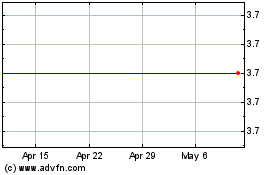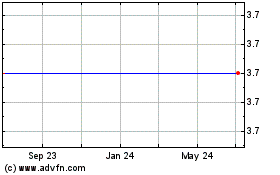NEW YORK (Dow Jones)--U.S. crude oil prices fell below $100 a
barrel Friday for the first time since early February--and promptly
tumbled past the $99 and $98 marks after a weak reading on U.S.
employment.
Light, sweet crude for June delivery recovered a bit by the end
of the day and settled $4.05, or 4%, lower at $98.49 a barrel on
the New York Mercantile Exchange, the lowest finish for the
benchmark since Feb. 7. The slide marks the biggest one-day drop
for the contract since December.
Futures have fallen 7.2% over the last three sessions.
Meanwhile, Brent crude on the ICE futures exchange settled $2.90
lower, or 2.5%, at $113.18 a barrel, its weakest finish since Feb.
2.
But oil futures have been grinding down since hitting a recent
settlement high of $109.77 on Feb. 26. Prices have been elevated
for months over tensions with Iran over its nuclear program. But
those prices have slowly succumbed to a steady drumbeat of
stabilizing supplies, weak demand and an eroding global
economy--with this most recent decline being particularly
steep.
"I'd always felt that the only thing holding the prices up above
$100 was the Iranian tensions," said John Kilduff, founding partner
at Again Capital in New York.
The decline should help consumers at the pump. If oil prices
stabilize below $100, the average U.S. price of regular
conventional gasoline should peak at $3.75 a gallon this summer,
down from the U.S. Energy Information Administration's expected
monthly average peak of $4.01 a gallon, said Richard Hastings,
macroeconomics analyst at Global Hunter Securities.
Moody's Analytics energy economist Chris Lafakis said that every
one-cent decline in gasoline prices adds $1.1 billion to consumer
spending over the course of a year.
"That's not insignificant," he added, "but it's still not too
much in the grand scheme of things."
Anxiety over Iran and its nuclear program have pushed up prices
for much of this year. Traders have been unwilling to let prices
fall too low and get caught by price spike caused by military
conflict or the sudden closure of the Strait of Hormuz, a major
channel for the world's seaborne oil.
Meanwhile, the European Union is set to ban Iranian oil imports
starting July 1, raising demand for oil from other sources and
lifting prices.
Analysts have said prices carried a $10-to-$15 fear premium due
to Iran.
But the anxieties have cooled a bit recently after Iran agreed
to multilateral talks aimed at resolving the nuclear standoff.
At the same time, worries of a supply squeeze are easing as
major oil producers boost oil production to ensure supply ahead of
the embargo. Saudi Arabia, the world's largest oil exporter, has
raised output to 10 million barrels a day in recent months. Also,
the United Arab Emirates is about to put in operation a pipeline
that will allow about 1.4 million barrels a day of its crude to
bypass the Persian Gulf and the Strait of Hormuz.
Also, U.S. inventories of crude oil are at 375.9 million
barrels, their highest level since 1990. The stockpiles have
ballooned by 11% in the past 12 weeks since benchmark U.S. crude
prices last traded below $100.
Meanwhile, the outlook for U.S. and global demand continues to
be hampered by a spate of uninspiring economic news.
On Friday, the Labor Department said U.S. nonfarm payrolls rose
just 115,000, less than the 168,000 rise seen by economists.
Unemployment crept lower to 8.1%, but vastly more people exited the
workforce than entered. Weak employment data typically correlates
with weaker oil demand because it means fewer motorists traveling
to work or taking vacations.
That is exactly what appears to be happening. The U.S. Energy
Information Administration, which in February projected a slim rise
in 2012 demand in the world's largest oil consumer, had scaled back
its view by April and now sees U.S. oil use dropping slightly to a
15-year low.
In Europe, the news is even worse. Spain disclosed this week
that it is officially in a recession. And a survey of economic
activity in the euro-zone found a faster contraction than
previously thought during April. The outlook for China, the world's
No. 2 oil consumer, is mixed at best.
The widely watch HSBC China Manufacturing Purchasing Managers
Index, a gauge of nationwide manufacturing activity, rose for
April, but still indicates the sector is contracting.
The slide in crude prices also hurt oil companies. Exxon Mobil
Corp. (XOM), Chevron Corp. (CVX) and other oil companies lose up to
$500 million in yearly profits on an annualized basis for every $1
drop in crude. The past six months of relatively high crude prices
allowed many of these companies to raise their dividends or offer
share buybacks, said Oppenheimer & Co. senior energy analyst
Fadel Gheit.
"They had a good ride so far, so the correction won't cause them
any heartbreak," he said.
Lower gasoline prices will also boost sales for Valero Energy
Corp.(VLO), Tesoro Corp. (TESO) and other refiners, who had been
expecting lackluster demand during what should be their peak summer
season. Refiners had been reporting April sales as flat or down
slightly compared with the year before.
To be sure, Iran remains the oil market's wild card. When crude
slips toward $100 a barrel, some investors "lose their stomach for
shorting it further on the fear that all hell could break lose in
the Middle East," said Bill O'Grady, chief market strategist for
Confluence Investment Management in St. Louis.
Based on the evolving supply-demand picture, traders may now be
willing to let prices test lower to levels, where some analysts say
the U.S. benchmark crude is fairly valued.
"I thought for sure we'd end up in the low $90s with the
flotilla of crude coming from Saudi Arabia," O'Grady said.
--Ben Lefebvre contributed to this article.
-By Dan Strumpf and David Bird, Dow Jones Newswires;
212-416-2818; dan.strumpf@dowjones.com
Tesco Corp. (MM) (NASDAQ:TESO)
Historical Stock Chart
From Mar 2024 to Apr 2024

Tesco Corp. (MM) (NASDAQ:TESO)
Historical Stock Chart
From Apr 2023 to Apr 2024
